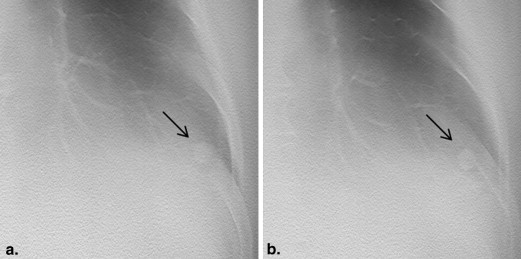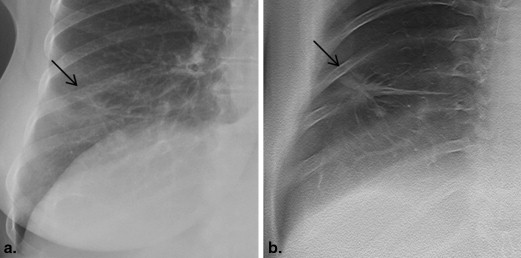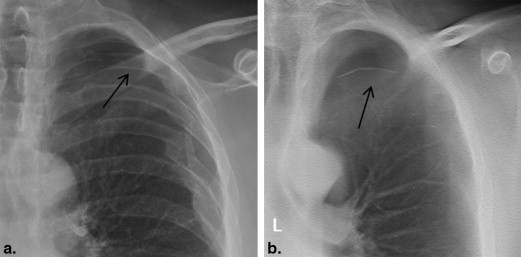Rationale and Objectives
To investigate potential benefits and drawbacks of the clinical use of chest tomosynthesis (CTS), to what extent CTS obviates the need for chest computed tomography (CT), and what reduction in radiation dose thereby can be achieved.
Materials and Methods
The Regional Ethical Review Board approved the follow-up study of patients examined with CTS as part of clinical routine. For each case, two radiologists in consensus determined whether CT would have been performed, had CTS not been an option, and whether CTS was an adequate examination. Thereafter, it was determined whether the use of CTS instead of CT in retrospect was beneficial, neutral, or detrimental for the radiological work-up. The radiation dose to the patient population was determined both for the actual clinical situation and for the alternative scenario that would result, had CTS not been available.
Results
During 1 month 3.5 years before the survey, 149 patients (74 women, age 18–91 years) had undergone CTS for clinical purposes. It was judged that CT would have been performed in 100 cases, had CTS not been available, and that CTS obviated the need for CT in 80 cases. CTS was judged as beneficial, neutral, and detrimental for the radiological work-up in 85, 13, and two cases, respectively. For the entire study population, the use of CTS decreased the average effective dose from 2.7 to 0.7 mSv.
Conclusions
The present study indicates that CTS may have benefits for the radiological work-up as it has the potential to both optimize the use of CT resources and reduce the effective dose to the patient population. A drawback is that CTS examinations may fail to reveal pathology visible with CT and in clinically doubtful cases further investigations including other imaging procedures should be considered.
Chest tomosynthesis (CTS) refers to the technique of acquiring multiple low-dose projection radiographs of the chest over a limited angular range and using these radiographs to reconstruct section images. In this way, a volumetric representation can be obtained at radiation doses lower than reported for computed tomography (CT) . Although the volumetric representation is not as isotropic as in CT, the section images contain much less of the overlaying anatomy than conventional chest radiographs (CXR). As the disturbance because of this anatomy may be the main limiting factor for detection of pathology in CXR , it can be anticipated that its reduction will lead to improved diagnostic accuracy with CTS in comparison to CXR.
A significant improvement for CTS in comparison to CXR in detection of pathology has been reported. The main focus of recent research has been detection and/or visibility of parenchymal nodules. Dobbins et al. found that 70% of CT-proven nodules were visible with CTS in contrast to 22% with CXR. Vikgren et al. obtained similar results, where 92% of CT-proven nodules were visible with CTS and 28% with CXR. This increased visibility of pulmonary lesions achieved with CTS has been reported to increase the diagnostic accuracy and confidence . Additionally, Vikgren et al. performed a detectability study and showed that only 16% of the CT-proven nodules were detected using CXR, whereas 56% were detected with CTS. The threefold increase in sensitivity thus reported by Vikgren et al. has later been confirmed in studies by Yamada et al. , Jung et al. , Zachrisson et al. , and Asplund et al. .
Get Radiology Tree app to read full this article<
Materials and methods
Get Radiology Tree app to read full this article<
Imaging Procedure
Get Radiology Tree app to read full this article<
Analysis of the use of CTS on the Radiological Outcome
Get Radiology Tree app to read full this article<
Get Radiology Tree app to read full this article<
Analysis of the use of CTS on the Radiation Dose
Get Radiology Tree app to read full this article<
Get Radiology Tree app to read full this article<
Get Radiology Tree app to read full this article<
Results
Study Population and Patient Characteristics
Get Radiology Tree app to read full this article<
Table 1
Description of the Study Population: Sex, Age, and Follow-Up Time Presented as the Number of Cases, Mean, Median (bold values), and Range ( n = numbers, yr = years, mo = months)
Sex Clinical Referrals ( n = 76) Radiological Referrals ( n = 73) Cases ( n ) Age (yr) Follow-Up (mo) Cases ( n ) Age (yr) Follow-Up (mo) Men ( n = 75) 39 61, 65 (18–85) 36, 44 (1–44) 36 59, 62 (21–91) 38, 44 (3–44) Women ( n = 74) 37 68, 71 (35–86) 41, 44 (3–44) 37 59, 61 (25–88) 37, 44 (2–44)
Get Radiology Tree app to read full this article<
Radiological Outcome
Get Radiology Tree app to read full this article<
Table 2
The Availability of CT Data for Confirming or Ruling out Pathology on the CTS Examinations and the Results of the CTS in Terms of Radiological Outcome
Criterion Clinical Referrals ( n = 76) Radiological Referrals ( n = 73) CT-proven pathology before CTS 57 (75%) 7 (10%) CT during follow-up 40 (53%) 33 (45%) CT if CTS not available 69 (91%) 31 (42%) CTS beneficial 58 (84%) 27 (87%) CTS neutral 10 (15%) 3 (10%) CTS detrimental 1 (1%) 1 (3%)
CT, computed tomography; CTS, chest tomosynthesis.
Get Radiology Tree app to read full this article<
Get Radiology Tree app to read full this article<
Get Radiology Tree app to read full this article<
Get Radiology Tree app to read full this article<
Get Radiology Tree app to read full this article<
Get Radiology Tree app to read full this article<
Get Radiology Tree app to read full this article<
Get Radiology Tree app to read full this article<
Radiation Dose
Get Radiology Tree app to read full this article<
Get Radiology Tree app to read full this article<
Get Radiology Tree app to read full this article<
Table 3
The Radiation Dose to the Patient Population for the Two Scenarios (the Actual Clinical Scenario and the Hypothetical Alternative Scenario)
Referral Type Clinical Scenario Alternative Scenario Examination Cases ( n ) Effective Dose (mSv) Examination Cases ( n ) Effective Dose (mSv) Clinical referrals ( n = 76) CTS ∗ 61 0.18 CXR 7 0.06 CT 54 4.0 CTS + CT 15 4.18 CT 15 4.0 Radiological referrals ( n = 73) CTS 68 0.14 None 42 0 CT 26 4.0 CTS + CT 5 4.14 CT 5 4.0
CT, computed tomography; CTS, chest tomosynthesis; CXR, chest radiograph.
Get Radiology Tree app to read full this article<
Get Radiology Tree app to read full this article<
Get Radiology Tree app to read full this article<
Discussion
Get Radiology Tree app to read full this article<
Get Radiology Tree app to read full this article<
Get Radiology Tree app to read full this article<
Get Radiology Tree app to read full this article<
Get Radiology Tree app to read full this article<
Get Radiology Tree app to read full this article<
Get Radiology Tree app to read full this article<
Get Radiology Tree app to read full this article<
Conclusions
Get Radiology Tree app to read full this article<
Get Radiology Tree app to read full this article<
References
1. Sabol J.M.: A Monte Carlo estimation of effective dose in chest tomosynthesis. Med Phys 2009; 32: pp. 5480-5487.
2. Båth M., Svalkvist A., von Wrangel A., et. al.: Effective dose to patients from chest examinations with tomosynthesis. Radiat Prot Dosimetry 2010; 139: pp. 153-158.
3. Kundel H.L., Nodine C.F., Thickman D., et. al.: Nodule detection with and without a chest image. Invest Radiol 1985; 20: pp. 94-99.
4. Samei E., Flynn M.J., Eyler W.R.: Detection of subtle lung nodules: relative influence of quantum and anatomic noise on chest radiographs. Radiology 1999; 213: pp. 727-734.
5. Båth M., Håkansson M., Börjesson S., et. al.: Nodule detection in digital chest radiography: introduction to the RADIUS chest trial. Radiat Prot Dosimetry 2005; 114: pp. 85-91.
6. Håkansson M., Båth M., Börjesson S., et. al.: Nodule detection in digital chest radiography: summary of the RADIUS chest trial. Radiat Prot Dosimetry 2005; 114: pp. 114-120.
7. Dobbins J.T., McAdams H.P., Song J.W., et. al.: Digital tomosynthesis of the chest for lung nodule detection: interim sensitivity results from an ongoing NIH-sponsored trial. Med Phys 2008; 35: pp. 2554-2557.
8. Vikgren J., Zachrisson S., Svalkvist A., et. al.: Comparison of chest tomosynthesis and chest radiography for detection of pulmonary nodules: human observer study of clinical cases. Radiology 2008; 249: pp. 1034-1041.
9. Kim E.Y., Chung M.J., Lee H.Y., et. al.: Pulmonary mycobacterial disease: diagnostic performance of low-dose digital tomosynthesis as compared with chest radiography. Radiology 2010; 257: pp. 269-277.
10. Quaia E., Baratella E., Cioffi V., et. al.: The value of digital tomosynthesis in the diagnosis of suspected pulmonary lesions on chest radiography: analysis of diagnostic accuracy and confidence. Acad Radiol 2010; 17: pp. 1267-1274.
11. Yamada Y., Jinzaki M., Hasegawa I., et. al.: Fast scanning tomosynthesis for the detection of pulmonary nodules: diagnostic performance compared with chest radiography, using multidetector-row computed tomography as the reference. Invest Radiol 2011; 46: pp. 471-477.
12. Jung H.N., Chung M.J., Koo J.H., et. al.: Digital tomosynthesis of the chest: utility for detection of lung metastasis in patients with colorectal cancer. Clin Radiol 2011; 67: pp. 232-238.
13. Zachrisson S., Vikgren J., Svalkvist A., et. al.: Effect of clinical experience of chest tomosynthesis on detection of pulmonary nodules. Acta Radiol 2009; 50: pp. 884-891.
14. Asplund S., Johnsson Å.A., Vikgren J., et. al.: Learning aspects and potential pitfalls regarding detection of pulmonary nodules in chest tomosynthesis and proposed related quality criteria. Acta Radiol 2011; 52: pp. 503-512.
15. Johnsson Å.A., Vikgren J., Svalkvist A., et. al.: Overview of two years of clinical experience of chest tomosynthesis at Sahlgrenska University Hospital. Radiat Prot Dosimetry 2010; 139: pp. 124-129.
16. Johnsson A.A., Vikgren J., Bath M.: Chest tomosynthesis: technical and clinical perspectives. Semin Respir Crit Care Med 2014; 35: pp. 17-26.
17. Quaia E., Baratella E., Cernic S., et. al.: Analysis of the impact of digital tomosynthesis on the radiological investigation of patients with suspected pulmonary lesions on chest radiography. Eur Radiol 2012; 22: pp. 1912-1922.
18. Quaia E., Baratella E., Poillucci G., et. al.: Digital tomosynthesis as a problem-solving imaging technique to confirm or exclude potential thoracic lesions based on chest X-ray radiography. Acad Radiol 2013; 20: pp. 546-553.
19. Quaia E., Grisi G., Baratella E., et. al.: Diagnostic imaging costs before and after digital tomosynthesis implementation in patient management after detection of suspected thoracic lesions on chest radiography. Insights Imaging 2014; 5: pp. 147-155.
20. Svalkvist A., Båth M.: Simulation of dose reduction in tomosynthesis. Med Phys 2010; 37: pp. 258-269.
21. Commission of the European Communities: European guidelines on quality criteria for computed tomography. Report EUR 16262 EN.1996.Office for Official Publications of the European CommunitiesLuxembourg
22. Young J.W.R., Andersen B.L., Reinig J.W.: Oblique chest film: value in routine and selective use. AJR Am J Roentgenol 1984; 142: pp. 69-72.
23. Dobbins J.T., McAdams H.P., Godfrey D.J., et. al.: Digital tomosynthesis of the chest. J Thorac Imaging 2008; 23: pp. 86-92.
24. Johnsson Å.A., Svalkvist A., Vikgren J., et. al.: A phantom study of nodule size evaluation with chest tomosynthesis and computed tomography. Radiat Prot Dosimetry 2010; 139: pp. 140-143.
25. Johnsson Å.A., Fagman E., Vikgren J., et. al.: Pulmonary nodule size evaluation with chest tomosynthesis. Radiology 2012; 265: pp. 273-282.
26. Asplund S.A., Johnsson Å.A., Vikgren J., et. al.: Effect of radiation dose level on the detectability of pulmonary nodules in chest tomosynthesis. Eur Radiol 2014; 24: pp. 1529-1536.
27. Svalkvist A., Månsson L.G., Båth M.: Monte Carlo simulations of the dosimetry of chest tomosynthesis. Radiat Prot Dosimetry 2010; 139: pp. 144-152.


